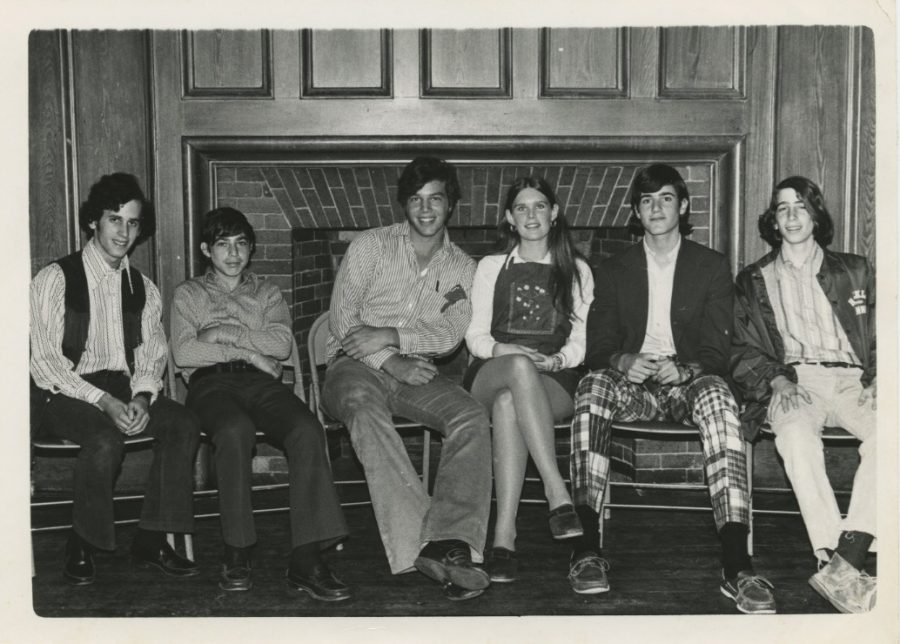Let’s talk about dress: reforming Hackley’s dress code
Credit: Photo courtesy of Hackley Archives
Hackley’s dress code in 1972 did not require students to wear jackets and ties, a change from prior years.
November 21, 2016
In today’s culture, there is a growing consciousness that gender is no longer a binary; it is a collection. Male and female are no longer the only prominent gender identities. With the shifting stance on gender, clothes that were once assigned to a certain sex have intermixed and been adopted by those whom identify as the opposite gender, no gender, or somewhere in between.
The Dial’s Editorial Board believes that Hackley’s dress code, as it stands now, does not reflect the progressive views and values we hold as a community, and that change should be enacted within the dress code to reflect those views and values. The Board believes that these rules should retain a level of tradition and professionalism that the dress codes currently maintains.
The topic of gender neutrality has been on the rise in the past few years. It has been acknowledged by celebrities like Jaden Smith, who was recently featured in Louis Vuitton’s spring/summer ad campaign, donning a skirt and leather jacket.
Jaden has also created a gender-neutral clothing line, MSFTS. “It’s pronounced ‘misfits.’ I took the ‘I’ out of ‘misfits’ because we’re a team and there is no ‘I’ in team. It’s a place for the lost kids and everyone to go, and something for them to have,” he said in an interview for Teen Vogue.
Phillips Exeter Academy in Exeter, New Hampshire has adopted a gender neutral dress code. Rather than having girls and boys sections, there is just one set of parameters. Students are allowed to wear dress shirts, sweaters, turtlenecks, and dresses and students’ clothes should be in good repair. Their outline of rules is simple and fair. The same sense of neatness and respect is expected of all students, and makes it less complicated for teachers and administration to enforce it.
When Hackley first started out as an all-boys prep school in 1899, the original uniform was a collared shirt, blazer, tie, and slacks. As the school moved through different periods of time, rules were added and taken out of the dress code in order to adjust to the times, while maintaining the same degree of respect for the community, its original intent.
When girls arrived on the Hilltop in 1970, their dress was restricted to skirts, dresses, tailored slacks or pantsuits. By 1971, boys were no longer required to wear jackets and ties, as long as they wore a button down shirt or turtleneck. Blue denim, athletic wear, sandals, and facial hair were not allowed; boys’ hair had to be above their collars. The following year, boys were allowed to wear their hair to their shoulders, and by 1979, boys’ hair merely had to be of “appropriate length.” The 1986-1987 parent student handbook added to their list of restrictions: military style clothing, “advertising slogans,” shorts, tee shirts, tank tops, bare midriffs, and “startling or inappropriate pictures.” The handbook also stated that, “earrings and similar jewelry of that type are not to be worn by male students.”
The tradition of showing respect for the community through a dress code should not go neglected, however; this can be done in a number of ways that do not have to replicate a dress code of 1970’s vintage.
Some might argue that the dress code stresses a sense of professionalism that Hackley students need to follow, because after all, we are a college preparatory school. However, the pieces that would comprise a gender-neutral dress code are not necessarily unprofessional.
Take, for example, the issue of hair length. A man with well-kept long hair might look just as professional as a man with short hair. In fact, the man with well-kept long hair might even look more professional than the man with short hair, if the man’s short hair was messy. Then, this might bring into question the whole notion of deciding whose long hair is well-kept and whose is not.
But if we, as a school, are taking this much time to debate the ‘kept-ness’ of a man’s long hair, then why aren’t we looking at the kept-ness of a man’s short hair? And if this goes, then why aren’t we regulating the kept-ness of girls’ hair? Should we really be regulating every single person’s hair or can we assume that everyone is taking some measures to make sure their hair looks ‘kept’? If this is the case, then couldn’t the handbook simply state that girls’ and boys’ hair have to be well-kept?
To a similar extent, a boy wearing a skirt, dress or earrings is just the same as a girl wearing a skirt, dress or earrings. In 1899, this wasn’t the norm for boys and was even looked down upon, but this isn’t 1899. Cultivating an open and accepting community should be reflected in our expectations for students and faculty, and in our dress code as well.
The World Health Organization also says, “Gender norms, roles and relations influence people’s susceptibility to different health conditions and diseases and affect their enjoyment of good mental, physical health and well-being.” Not only is a gender-neutral dress code necessary out of principle, but the stress potentially created without it can negatively affect an individual’s health.

